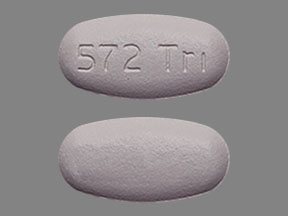Triumeq Dosage
Generic name: ABACAVIR SULFATE 600mg, DOLUTEGRAVIR SODIUM 50mg, LAMIVUDINE 300mg
Dosage form: tablet, film coated
Drug class: Antiviral combinations
Medically reviewed by Drugs.com. Last updated on Jul 8, 2024.
Screening for HLA−B*5701 Allele prior to Initiating TRIUMEQ
Screen for the HLA‑B*5701 allele prior to initiating therapy with TRIUMEQ or TRIUMEQ PD.
Testing prior to or When Initiating Treatment with TRIUMEQ
Prior to or when initiating TRIUMEQ or TRIUMEQ PD, test patients for HBV infection.
Overview of TRIUMEQ Dosage Forms
TRIUMEQ is available in two dosage forms. Do not substitute TRIUMEQ tablets and TRIUMEQ PD tablets for oral suspension on a milligram-per-milligram basis due to differing pharmacokinetic profiles for the dolutegravir component.
- •
- TRIUMEQ tablets: 600 mg of abacavir, 50 mg of dolutegravir, and 300 mg of lamivudine. TRIUMEQ is recommended in adults and pediatric patients weighing at least 25 kg.
- •
- TRIUMEQ PD tablets for oral suspension: 60 mg of abacavir, 5 mg of dolutegravir, and 30 mg of lamivudine. TRIUMEQ PD is recommended in pediatric patients weighing 6 kg to less than 25 kg.
- •
- Because TRIUMEQ PD is a fixed-dose tablet and the dosage of individual components cannot be adjusted, it may lead to a suboptimal dosing for patients weighing ≥25 kg. TRIUMEQ PD is not recommended in patients weighing 25 kg or more.
Recommended Dosage in Adults
TRIUMEQ is a fixed-dose combination product containing 600 mg of abacavir, 50 mg of dolutegravir, and 300 mg of lamivudine. The recommended dosage regimen of TRIUMEQ in adults is one tablet once daily orally with or without food. Do not use TRIUMEQ PD in adults.
Recommended Dosage and Administration Instructions for Pediatric Patients Weighing at Least 6 kg
The dosage and dosage form recommended for pediatric patients varies by weight as shown in Table 1 below.
| a TRIUMEQ is a fixed-dose combination product containing 600 mg of abacavir, 50 mg of dolutegravir, and 300 mg of lamivudine. | |||
| b TRIUMEQ PD is a fixed-dose combination product containing 60 mg of abacavir, 5 mg of dolutegravir, and 30 mg of lamivudine. | |||
|
Body Weight |
TRIUMEQ Tabletsa |
TRIUMEQ PDb Number of Tablets |
Total Daily Dose |
|
6 kg to <10 kg |
Not recommended |
3 tablets once daily |
180 mg abacavir, 15 mg dolutegravir, and 90 mg lamivudine once daily |
|
10 kg to <14 kg |
Not recommended |
4 tablets once daily |
240 mg abacavir, 20 mg dolutegravir, and 120 mg lamivudine once daily |
|
14 kg to <20 kg |
Not recommended |
5 tablets once daily |
300 mg abacavir, 25 mg dolutegravir, and 150 mg lamivudine once daily |
|
20 kg to <25 kg |
Not recommended |
6 tablets once daily |
360 mg abacavir, 30 mg dolutegravir, and 180 mg lamivudine once daily |
|
≥25 kg |
1 tablet once daily |
Not recommended |
600 mg of abacavir, 50 mg of dolutegravir, and 300 mg of lamivudine |
Administer TRIUMEQ PD tablets for oral suspension with or without food. Instruct patients (or instruct caregivers) to fully disperse the tablets for oral suspension in 20 mL of drinking water (if using 4, 5, or 6 tablets for oral suspension) or 15 mL (if using 3 tablets for oral suspension) in the supplied cup; swirl the suspension so that no lumps remain. After full dispersion, administer the oral suspension within 30 minutes of mixing. Do not swallow the tablets for oral suspension whole, and do not chew, cut, or crush the tablets.
For children unable to use the supplied cup, an appropriate-sized syringe may be used to administer the oral suspension.
Administer TRIUMEQ tablet with or without food. Do not chew, cut, or crush the tablet.
Dosage Recommendation with Certain Concomitant Medications
The dolutegravir dose in TRIUMEQ (50 mg) and TRIUMEQ PD (5 mg) is insufficient when coadministered with medications listed in Table 2 that may decrease dolutegravir concentrations; the following dolutegravir dosage regimen is recommended.
|
Coadministered Drug |
Dosing Recommendation |
|
Efavirenz, fosamprenavir/ritonavir, tipranavir/ritonavir, carbamazepine, or rifampin |
In adults and in pediatric patients weighing at least 25 kg, the recommended dolutegravir dosage regimen is 50 mg twice daily. Thus, an additional TIVICAY 50-mg tablet, separated by 12 hours from TRIUMEQ, should be taken. In pediatric patients weighing 6 kg to <25 kg, an additional weight-based dose of dolutegravir should be given separated by 12 hours from TRIUMEQ PD.
|
Not Recommended Due to Lack of Dosage Adjustment
Because TRIUMEQ and TRIUMEQ PD are fixed-dose tablets and cannot be dose adjusted, TRIUMEQ and TRIUMEQ PD are not recommended in:
- •
- patients with creatinine clearance <30 mL/min and pediatric patients with a similar degree of renal impairment based on age-appropriate renal function assessment. There are no data available on the use of lamivudine, a component of TRIUMEQ and TRIUMEQ PD, in pediatric patients with renal impairment.
- •
- patients with mild hepatic impairment. TRIUMEQ and TRIUMEQ PD are contraindicated in patients with moderate or severe hepatic impairment.
Frequently asked questions
- Can Triumeq be used for PrEP?
- Does Triumeq cause erectile dysfunction?
- Can Triumeq be crushed or split?
- Triumeq vs Genvoya. How do they compare?
- How long does it take for Triumeq to work?
- Does Triumeq cause weight gain?
- Does Triumeq cause hair loss?
- Is Triumeq an immunosuppressant?
- Is Triumeq a protease inhibitor?
More about Triumeq (abacavir / dolutegravir / lamivudine)
- Check interactions
- Compare alternatives
- Pricing & coupons
- Reviews (127)
- Drug images
- Side effects
- Patient tips
- During pregnancy
- Support group
- FDA approval history
- Drug class: antiviral combinations
- En español
Patient resources
Other brands
Professional resources
Related treatment guides
See also:
Further information
Always consult your healthcare provider to ensure the information displayed on this page applies to your personal circumstances.


